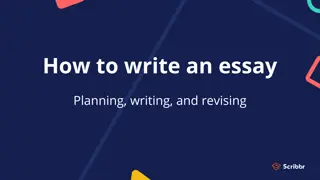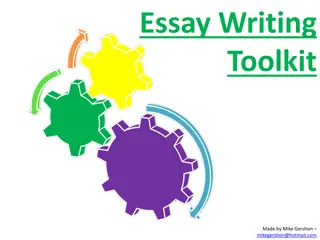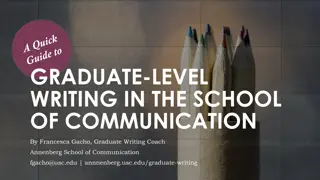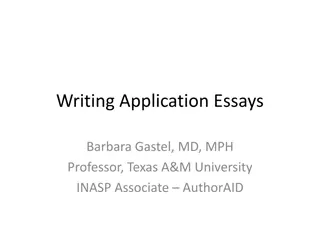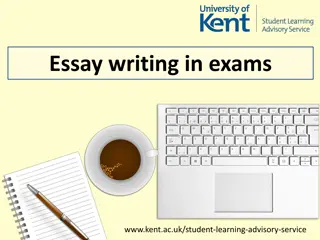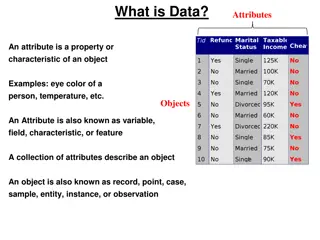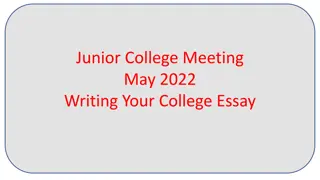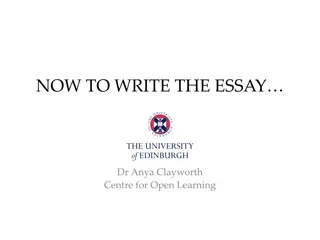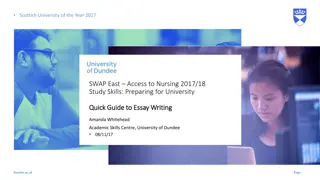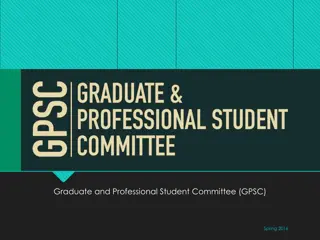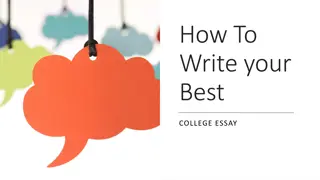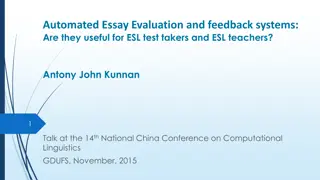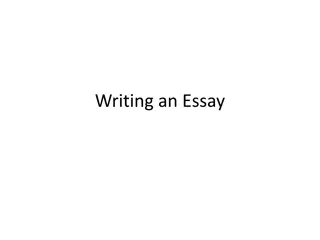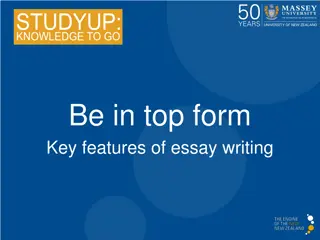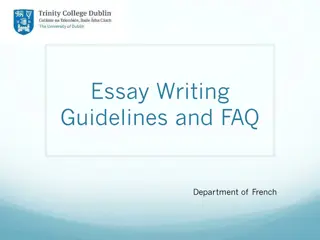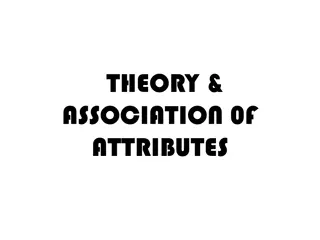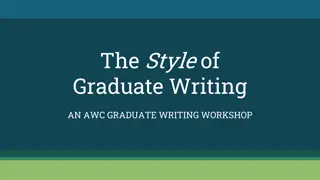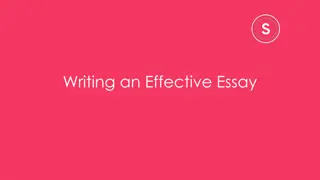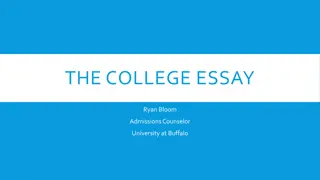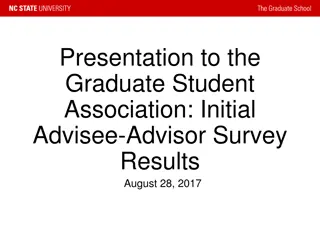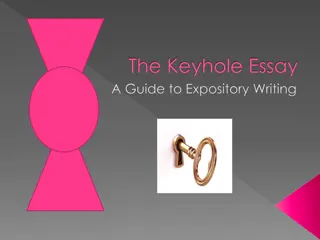Understanding Graduate Attributes and Essay Writing Structures
Explore the concepts of graduate attributes, essay writing structures, and SOLO taxonomy in education. Understand the levels of understanding using SOLO Taxonomy and learn about the PESEL methodology for effective essay writing. Discover ways to introduce academic essays and the importance of defining key terms. Enhance your understanding of various educational frameworks and models to improve your academic writing skills.
Download Presentation

Please find below an Image/Link to download the presentation.
The content on the website is provided AS IS for your information and personal use only. It may not be sold, licensed, or shared on other websites without obtaining consent from the author. Download presentation by click this link. If you encounter any issues during the download, it is possible that the publisher has removed the file from their server.
E N D
Presentation Transcript
Graduate Attributes
Graduate Attributes Essay Writing Discuss structure and language
SOLO Taxonomy (Structure of SOLO Taxonomy (Structure of Observed Learning Outcomes) Observed Learning Outcomes) provides a model for different levels provides a model for different levels of understanding, including surface, of understanding, including surface, deep and conceptual (Biggs and deep and conceptual (Biggs and Collis 1982) Collis 1982)
SOLO Prestructural: The task is inappropriately attempted. The student requires help or has misunderstood. Unistructural: One aspect of the task is achieved, but student understanding is disconnected and limited. Multistructural: Several aspects of the task are achieved but their relationships as a whole are not fully realised. Relational: Aspects of the task are linked and integrated and contributed to a deeper understanding as a whole Extended Abstract: New understanding at the previous relational level is re-thought at another conceptual level and in a new way, and is the basis for prediction, generalisation, reflection, or creation of new understanding.
PESEL Point - make your point Explain - explain your reasoning Support - support your point with evidence Evaluate - evaluate your point and evidence Link - link to the next paragraph
Your Assignment Intro Factor Factor Factor
Introductions There are many ways to introduce an academic essay or short paper. Most academic writers, however, appear to do one or more of the following in their introductions: establish the context, background and/or importance of the topic present an issue, problem, or controversy in the field of study define the topic and/or key terms used in the paper Introductory phrases for Definitions: The term X was first used by The term X can be traced back to Previous studies mostly defined X as The term X was introduced by Smith in her Historically, the term X has been used to describe
General comments on the relevant literature The literature on X has highlighted several Different theories exist in the literature regarding More recent attention has focused on the provision of Much of the literature since the mid-1990s emphasises the Much of the current literature on X pays particular attention to The existing literature on X is extensive and focuses particularly on There is a relatively small body of literature that is concerned with
General comments on the relevant literature Some ways of introducing quotations Commenting on X, Smith (2003) argues: As Carnoy (2004: 215) states: there are many good reasons to be sceptical . As Smith argues: In the past, the purpose of education was to (Smith, 2000:150). Sachs concludes: The idea of development stands today like a ruin in (Sachs, 1992a: 156).
Expressing a causal relationship X may have been an important factor in X may have contributed to the increase in X may have played a vital role in bringing about In the literature, X has been associated with Y. There is some evidence that X may affect Y. The use of X may be linked to behaviour problems in
Introducing the critical stance of particular writers Jones (2003) has also questioned why However, Jones (2003) points out that The author challenges the widely held view that Smith (1999) takes issue with the contention that The idea that was first challenged by Smith (1992). Jones (2003) has challenged some of Smith s conclusions, arguing that Another major criticism of Smith s study, made by Jones (2003), is that An alternative interpretation of the origins of X can be found in Smith (1976). In a recent article in Academic Journal, Smith (2014) questions the extent to which A recently published article by Smith et al. (2011) casts doubt on Jones assumption that
Discussing Theories and Research Research is an essential part of any good academic paper. Without it, claims and opinions are not viable and hardly believable. Plus, without research, it is difficult to know much about your chosen subject. By providing evidence of research, readers can trust what you write is concrete, accurate to the best of your knowledge, and reliable. a certain study, indicated that several schools of thought have emerged prior research has suggested the underlying concept the likelihood that the central issue addressed here is the relationship between the topic of warrants research attention for reasons. there is evidence that has a positive effect. these arguments suggest
Explanation Explaining the topics and issues within your main subject is intrinsic for writing well in academic writing. that is to say to that end . in truth in fact also as well foremost meaning
Adding Additional Information to Support a Point It is never enough to give one line of thought to describe or support a claim. A claim is always weak if it is backed up in a one-sided way. That is why it is important to give a comprehensive view of your main topic to your readers. furthermore likewise similarly another key thing to remember not only . but also coupled with subsequently not to mention in addition,
Demonstrating Contrast / Opposing Points When writing persuasive essays, compare and contrast essays, or any essay that focuses on giving a comprehensive view on a subject, knowing how to contrast your main topic and subtopics with opposing information is important. however, on the other hand, by comparison, nonetheless, on the contrary, in contrast nevertheless, notwithstanding conversely, a clear difference a conflicting viewpoint
Signifying Importance When you want to show that a certain point in your writing is significant or should be paid more attention to, you can use certain transition words and phrases to do so. Sometimes, without words and phrases that mark or point out the importance of a certain point, an essay can get disorganized. significantly notably, the key to take into consideration importantly indeed without a doubt undoubtedly certainly surely above all,
Reference to previous research Support These findings further support the idea of . This finding confirms the association between . This study confirms that X is associated with . The findings of the current study are consistent with those of Smith and Jones (2001) who . These results are consistent with those of other studies and suggest that .
Summarising When you have written a large chunk of information, it is important to summarise information for your readers so they can firmly grasp what has been presented. conclusive evidence overall in conclusion above all compelling all things considered to summarize, to conclude as was previously stated, as has been mentioned, given these points, consequently,
Reference to previous research Contradict However, the findings of the current study do not support the previous research. This study has been unable to demonstrate that . However, this result has not previously been described. In contrast to earlier findings, however, no evidence of X was detected. These results differ from X s 2003 estimate of Y, but they are broadly consistent with earlier .
Conclusions Conclusions are shorter sections of academic texts which usually serve two functions. The first is to summarise and bring together the main areas covered in the writing, which might be called looking back ; and the second is to give a final comment or judgement on this. The final comment may also include making suggestions for improvement and speculating on future directions.
Conclusions Restatement of aims This paper has argued that . This study set out to determine . This essay has discussed the reasons for . The present study was designed to determine the effect of . One of the more significant findings to emerge from this study is that . It was also shown that . The results of this investigation show that
Conclusions Suggesting implications The evidence from this study suggests that . The following conclusions can be drawn from the present study . The results of this study indicate that . The results of this research support the idea that . An implication of this is the possibility that . The findings of this study suggest that .
Conclusions Recommendations for further research work This research has thrown up many questions in need of further investigation. What is now needed is a cross-national study involving . More broadly, research is also needed to determine . More research is needed to better understand when implementation ends and . More research is required to determine the efficacy of
Conclusions Implications or recommendations for practice or policy Other types of X could include: a), b). . There is, therefore, a definite need for . Moreover, more X should be made available to . Another important practical implication is that .
Critical Writing Presents reasoning and evidence in a clear well structured manner Examines information from different angles, standpoints Weighs one piece of evidence against another Does not accept the conclusions of writers without evaluating the arguments and evidence they provide A presentation of why the writing of authors should be accepted or questioned. Is the evidence from a valid/reliable source? A clear delivery of own evidence, identifying any limitations Makes informed conclusions
Activity Look at the following pieces of writing and decide whether you think the writing is descriptive or critical 1. There is considerable speculation about whether we face a future of ever increasing plastic waste (Barnes, 2019). Globally we now produce over 300 million tonnes of plastic each year (Brink et al., 2018). 2. Anti-plastic campaigns are part of the wider environmental campaigns attempting to tackle climate change (Avery-Gomm et al., 2019). 3. The focus on the elimination of single use plastics and the individual s change in practice does not address wider issues of over consumption. 4. There are a number of inherent difficulties in evaluating the Grove plan (2018) for the elimination of plastic waste. This has contributed to controversy within research literature (Marshall, 2018). Firstly there is no doubt that the Grove plan has merits (Cottrell 2019) however there is little evidence to say that the plan is financially viable (Grubb, 2020).
Answer Answer 1: Descriptive The writer is simply describing the current situation Answer 2: Descriptive The writer is simply describing the current situation Answer 3: Critical However the writer needs to substantiate the claim does not address by providing evidence from their own research, data or viewpoints of other authors Answer 4: Critical The writer is considering the available evidence, but also the limitations of the evidence



